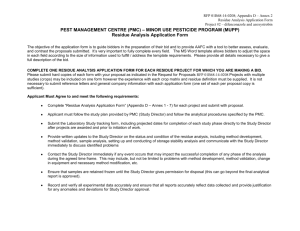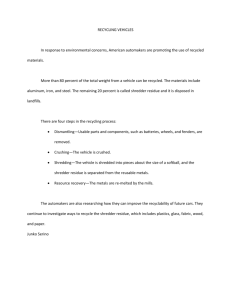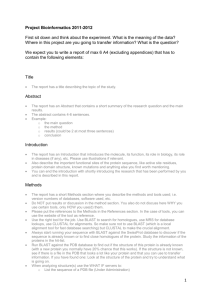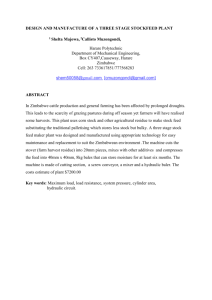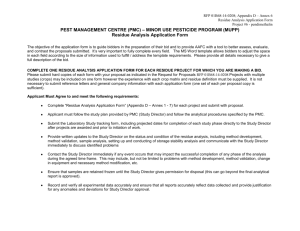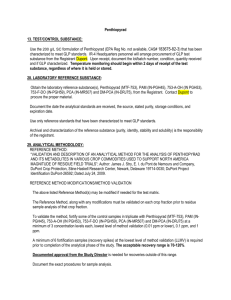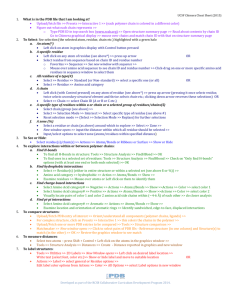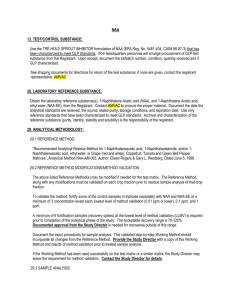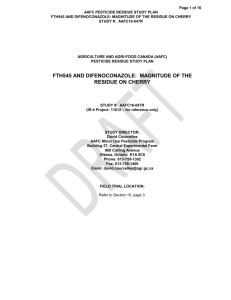appendix_d_-_annex_8_
advertisement
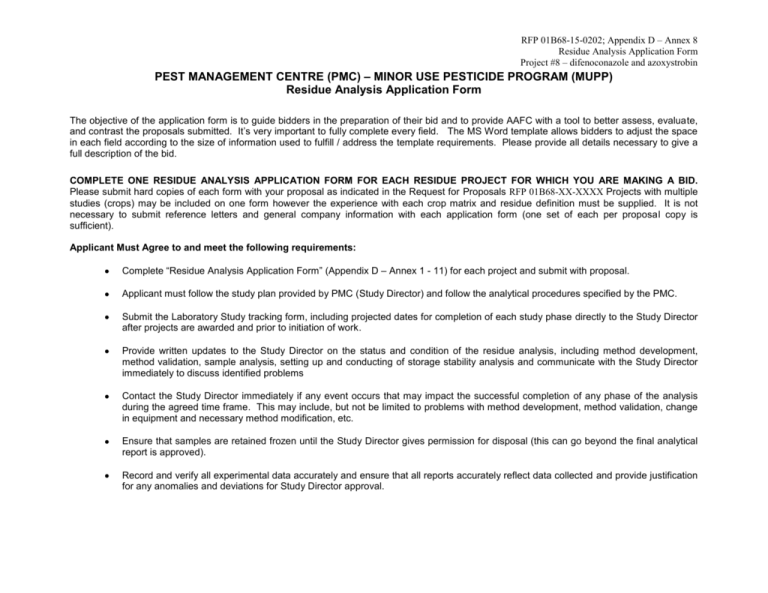
RFP 01B68-15-0202; Appendix D – Annex 8 Residue Analysis Application Form Project #8 – difenoconazole and azoxystrobin PEST MANAGEMENT CENTRE (PMC) – MINOR USE PESTICIDE PROGRAM (MUPP) Residue Analysis Application Form The objective of the application form is to guide bidders in the preparation of their bid and to provide AAFC with a tool to better assess, evaluate, and contrast the proposals submitted. It’s very important to fully complete every field. The MS Word template allows bidders to adjust the space in each field according to the size of information used to fulfill / address the template requirements. Please provide all details necessary to give a full description of the bid. COMPLETE ONE RESIDUE ANALYSIS APPLICATION FORM FOR EACH RESIDUE PROJECT FOR WHICH YOU ARE MAKING A BID. Please submit hard copies of each form with your proposal as indicated in the Request for Proposals RFP 01B68-XX-XXXX Projects with multiple studies (crops) may be included on one form however the experience with each crop matrix and residue definition must be supplied. It is not necessary to submit reference letters and general company information with each application form (one set of each per proposal copy is sufficient). Applicant Must Agree to and meet the following requirements: Complete “Residue Analysis Application Form” (Appendix D – Annex 1 - 11) for each project and submit with proposal. Applicant must follow the study plan provided by PMC (Study Director) and follow the analytical procedures specified by the PMC. Submit the Laboratory Study tracking form, including projected dates for completion of each study phase directly to the Study Director after projects are awarded and prior to initiation of work. Provide written updates to the Study Director on the status and condition of the residue analysis, including method development, method validation, sample analysis, setting up and conducting of storage stability analysis and communicate with the Study Director immediately to discuss identified problems Contact the Study Director immediately if any event occurs that may impact the successful completion of any phase of the analysis during the agreed time frame. This may include, but not be limited to problems with method development, method validation, change in equipment and necessary method modification, etc. Ensure that samples are retained frozen until the Study Director gives permission for disposal (this can go beyond the final analytical report is approved). Record and verify all experimental data accurately and ensure that all reports accurately reflect data collected and provide justification for any anomalies and deviations for Study Director approval. RFP 01B68-15-0202; Appendix D – Annex 8 Residue Analysis Application Form Project #8 – difenoconazole and azoxystrobin Applicants must be able to complete the residue analysis, including submission of reports and raw data, by December 31, 2017. Circumstances that may preclude delivery of reports by this date including sample shipment dates, storage stability analyses, etc., must be discussed with the Study Director and a revised due date approved. Delays in the delivery of the raw data and final analytical report including storage stability data must be justified and approved by the Study Director. If acceptable justification is not provided a 10% decrease on the remaining contract balance will be applied for each month delay. Note: Any proposed changes by the applicant, discussed below may not be acceptable to the Pest Management Centre and the successful bidder may have to follow the reference method as written or with some agreed changes. RFP 01B68-15-0202; Appendix D – Annex 8 Residue Analysis Application Form Project #8 – difenoconazole and azoxystrobin RESIDUE ANALYSIS APPLICATION FORM Residue Analysis Application Form Project # 8 Study number: AAFC15-053R Product (Active ingredient): Quadris Top/ (difenoconazole and azoxystrobin) Registrant: Syngenta 1 Name of Organization 2 Mailing Address 3 Phone & Facsimile 4 E-mail & Web Address 5 Contact Person Tel: Fax: E-mail: Website: Name/Title: E-mail: Principal Investigator details: Name: Tel: Fax: E-mail: Rated Requirements Maximum points RFP 01B68-15-0202; Appendix D – Annex 8 Residue Analysis Application Form Project #8 – difenoconazole and azoxystrobin R1 - Describe your project team and their responsibilities and how they will be accountable 5 R2 - Demonstration of understanding of project requirements: (a and b combined) 60 (2a and 2b combined) R2A. Provide details of direct experience with the exact crop matrices listed and the analytes in the residues concern (listing crops and methodology used). Quantify the number of studies with each matrix and each analyte in your example. If you do not have exact experience, provide experience with related crop(s), residue definition, etc., in 2b. Crop Fraction(s): 25 Radish – Root Residue(s) of concern: 25 difenoconazole azoxystrobin R230310 Analytical methods Storage Stability Residue Method for the Determination of Residues of Difenoconazole (CGA 169374) in Various Crops and Processed Crop Fractions. Final Determination by LC-MS/MS, T. Clark. (2004). Report T003341-06, Analytical Method No. REM 147.08, Syngenta, UK, April 11, 2004, 54 pages Residue Analytical Method for the Determination of Azoxystrobin (ICI5504) and R230310 in Crop Samples. Final Determination by LC-MS/MS, S. Chaggar, S.J. Crook, E.A. Harron and N.J. Robinson. (2004). Syngenta Standard Operating Procedure RAM 305/03, November 25, 2004, 65 pages If stored more than 24 months. 10 R2B. For any crop matrix or residue definition listed in part 2a, provide experience(s) with similar matrices and the residue definition, along with an explanation of how this experience will be beneficial in undertaking this project. Experience with other matrices that will be relevant to this project, and why. 30 Experience with other residue definitions that will 15 15 RFP 01B68-15-0202; Appendix D – Annex 8 Residue Analysis Application Form Project #8 – difenoconazole and azoxystrobin be beneficial for this project, and why. R2C. Understanding Analytical Methodology Based on the reference method, provide an overview of the procedures to be used for each study in the project. This overview is to include a summary/description of the analytical techniques needed to complete this analysis, why they are relevant (Soxhlet extraction used to extract ethofumesate from sample), any proposed modifications, explaining why they are required (i.e., method required packed column with GC/NPD determination. Equipment is not capable of handling packed columns) , the method of calculation and concerns/restraints. Also provide an estimate of the timeframe it will take to analyze the sample. i.e. 36 samples at 12/day = 3 days. If proposed changes are not acceptable to PMC, can you follow the method as written? Outline of analytical method, providing details on how the lab will analyze samples, proposed modifications, and concerns. 30 Concerns: R2D. Understanding Requirements of Study Plan Based on the draft study plan template, provide an outline of the procedures to be used for each study in the project. This outline is to include details on each phase of analysis. Outline any potential concerns, explaining why and providing solutions. Outline of method validation process. Outline of sample analysis process (including time frame, number of set, etc.) Outline of standard stability 30 RFP 01B68-15-0202; Appendix D – Annex 8 Residue Analysis Application Form Project #8 – difenoconazole and azoxystrobin Outline of frozen storage stability analysis and requirements of each phase. Concerns: R2E. Understanding and adhering to quality control Based on your SOPs and good scientific practices, provide guidelines for data reproducibility and outline how your organization handles inconsistencies in data or unexpected results, For example: a) quantifiable residue levels in an untreated sample on par with the levels in a treated sample; b) 1 trial with results significantly different than other trials within the study; c) one of the method validation recovery results is low (98, 95, 22%). Please outline any other types of inconsistencies which may be relevant to this study. Result anomalies 10 R2F. Demonstrating understanding of data accuracy/presentation/ and mitigation measures if modifications are required Based on the draft study plan and reference method, provide the LOD and LOQ for the method and the implication this will have on the studies in this project. If the LOD and LOQ need to be modified as part of the study, describe the process your lab would use. Method LOD/LOQ 10 R2G. Demonstrating how solutions will be prepared and used Based on the draft study plan and reference method, provide an overview on how the reference items (analytical standards) will be prepared. Outline any potential concerns, explaining why and providing potential solutions. Analytical standards 10
